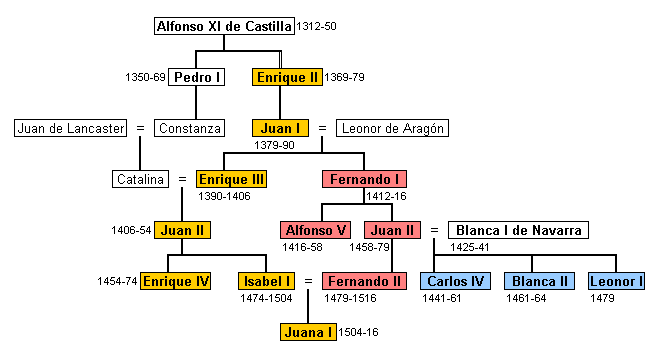House of Trastámara
The House of Trastámara was a dynasty of Castilian origin that ruled the Crown of Castile from 1369 to 1555, the Crown of Aragon from 1412 to 1555, the kingdom of Navarre from 1425 to 1479 and from 1512 to 1555, and the kingdom of Naples from 1458 to 1501 and from 1504 to 1555.
The House, a minor branch of the reigning House of Burgundy, takes its name from the county of Trastámara (Latin: Tras Tamaris, 'beyond the river Tambre') in northwest Galicia, a title held by Enrique II of Castile before acceding to the throne. Enrique became King of Castile after the civil war that ended with the assassination in 1369 of his half-brother, King Pedro I.
Under the different reigns of the Trastámara, the monarchical authority achieved by Pedro I and the economic development that had been promoted by the bourgeoisie weakened. At the same time, under his governments, a policy that will lead later to the so-called authoritarian monarchies is manifested very well. They managed to involve Castile in the Hundred Years' War, allowing European diplomacy to interfere in the affairs of the kingdom.
The House of Trastámara came to reign in Aragon through the compromise of Caspe (1412), which put an end to the succession crisis caused by the death without issue of Martín I the Human in 1410. There, contrary to the loss of authority suffered by the Castilian Trastámaras, the Aragonese branch fought to consolidate the king's power in territories where the constitutions and charters of each kingdom limited its capacity for action. Fernando I expressed his rejection of these privileges, and in the long run, under Juan II of Aragon and Fernando el Católico, the Trastámara were able to overcome part of the obstacles of the peculiar feudalizing organization of the Crown of Aragon, although due to the war between Juan II and the General Council of the Principality of Catalonia, were left behind in the economic recovery that had been taking place since the debacle of the Black Death and the crisis of the 14th century.
The last monarch of this house to rule in Spain was Queen Juana I of Castile, who by her marriage to Felipe of Austria and through their son, Carlos I, gave way to the government of Spain by kings of the House from Austria.

